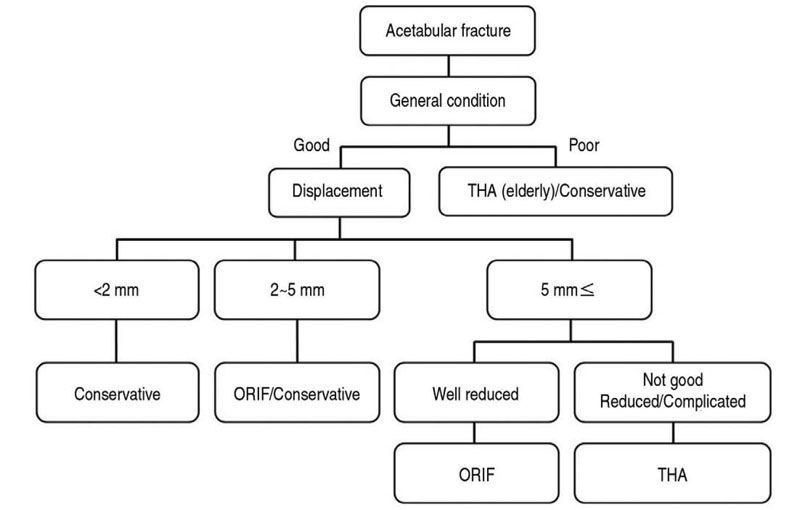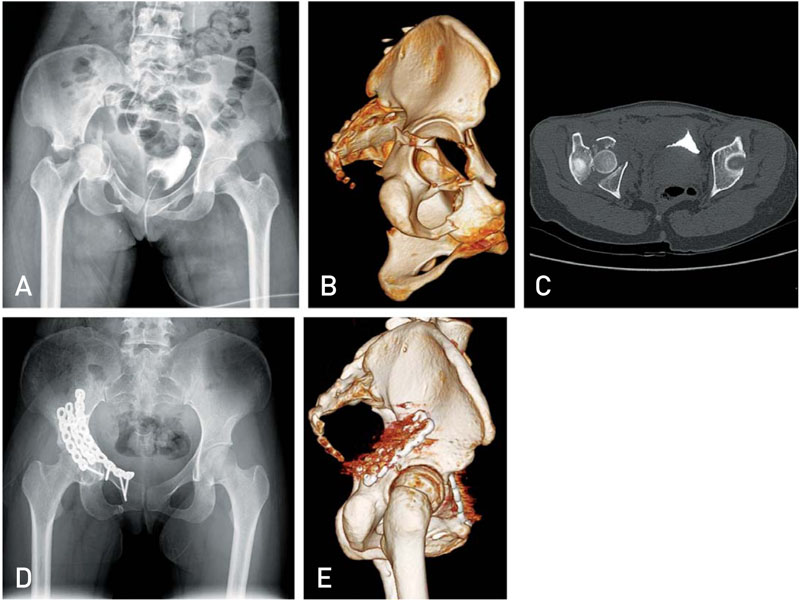Hip Pelvis.
2013 Sep;25(3):158-165. 10.5371/hp.2013.25.3.158.
Treatment of the Acetabular Fracture
- Affiliations
-
- 1Department of Orthopedic Surgery, School of Medicine, The Chosun University, Gwangju, Korea. shalee@chosun.ac.kr
- KMID: 1974370
- DOI: http://doi.org/10.5371/hp.2013.25.3.158
Abstract
- Acetabular fractures resulting from a high-energy injury show variable forms according to each fracture mechanism, and are composed of complex anatomical structures. Plain radiographs accompanying three-dimensional computer tomography is inevitable, because it is necessary to perform a multidirectional imaging analysis as a diagnosis. Conservative treatment, open reduction with internal fixation, percutaneous screw fixation, and primary artificial hip replacement can be performed. Despite the various treatment methods to the associated injuries, such as comminuted fracture, articular surface injury, poor bone quality and etc, are huge burden for the treatment. Further, there are varying complications, such as thromboembolism, post-traumatic osteoarthritis, avascular necrosis, infection, nerve palsy, heterotopic bone formation and etc. Therefore, physicians need to an accurate classification of fracture and be able to provide rehabilitation, as soon as possible, after rigid internal fixation via open anatomical articular reduction. also In addition, physicians must also pay great attention to prevent complications.
Keyword
MeSH Terms
Figure
Reference
-
1. Moed BR, Reilly MC. Acetabulum fractures. In : Robert WB, James DH, Charles CB, editors. Rockwood and Green's fractures in adult. 7th ed. Philadelphia: Lippincott Williams & Wilkins;2010. p. 1463–1521.2. Judet R, Judet J, Lanzetta A, Letournel E. Fractures of the acetabulum. Classification and guiding rules for open reduction. Arch Ortop. 1968; 81:119–158.3. Müller ME, Allgöwer M. Manual of internal fixation: techniques recommended by the AO-ASIF goup. 3rd ed. Berlin: Springer-Verlag;1991.4. Tile M, Helfet DL, Kellam JF. Fracture of the pelvis and acetabulum. 3rd ed. Phildelphia: Williams & Wilkins;2003. p. 417–833.5. Kang HJ, Ko SH, Kim BS, et al. Principles of fracture management. 1st ed. Seoul: Bummun education;2013. p. 567–579.6. Matta JM, Mehne DK, Roffi R. Fractures of the acetabulum. Early results of a prospective study. Clin Orthop Relat Res. 1986; (205):241–250.7. Matta JM, Anderson LM, Epstein HC, Hendricks P. Fractures of the acetabulum. A retrospective analysis. Clin Orthop Relat Res. 1986; (205):230–240.8. Tipton WW, D'Ambrosia RD, Ryle GP. Non-operative management of central fracture-dislocations of the hip. J Bone Joint Surg Am. 1975; 57:888–893.
Article9. Templeman DC, Olson S, Moed BR, Duwelius P, Matta JM. Surgical treatment of acetabular fractures. Instr Course Lect. 1999; 48:481–496.10. Goulet JA, Rouleau JP, Mason DJ, Goldstein SA. Comminuted fractures of the posterior wall of the acetabulum. A biomechanical evaluation of fixation methods. J Bone Joint Surg Am. 1994; 76:1457–1463.
Article11. Matta JM, Letournel E, Browner BD. Surgical management of acetabular fractures. Instr Course Lect. 1986; 35:382–397.12. Guyton JL, Perez EA. Fractures of acetabulum and pelvis. In : Canale ST, Beaty JH, editors. Campbell's operative orthopaedics. 12th ed. Philadelphia: Mosby;2013. p. 2777–2799.13. Sanders MB, Starr AJ, Reinert CM. Percutaneous screw fixation of acetabular fracutres in elderly patients. Curr Opin Orthop. 2006; 17:17–24.14. Ward AJ, Chesser TJ. The role of acute total hip arthroplasty in the treatment of acetabular fractures. Injury. 2010; 41:777–779.
Article15. Romness DW, Lewallen DG. Total hip arthroplasty after fracture of the acetabulum. Long-term results. J Bone Joint Surg Br. 1990; 72:761–764.
Article16. Sharrock NE, Brien WW, Salvati EA, Mineo R, Garvin K, Sculco TP. The effect of intravenous fixed-dose heparin during total hip arthroplasty on the incidence of deep-vein thrombosis. A randomized, double-blind trial in patients operated on with epidural anesthesia and controlled hypotension. J Bone Joint Surg Am. 1990; 72:1456–1461.
Article17. Johnson R, Carmichael JH, Almond HG, Loynes RP. Deep venous thrombosis following Charnley arthroplasty. Clin Orthop Relat Res. 1978; (132):24–30.
Article18. Letournel E. Acetabulum fractures: classification and management. Clin Orthop Relat Res. 1980; (151):81–106.
Article19. Mears DC, Velyvis JH. Primary total hip arthroplasty after acetabular fracture. Instr Course Lect. 2001; 50:335–354.
Article20. Tornetta P 3rd, Reilly M, Matta J. Acetabular fracture/dislocation. J Orthop Trauma. 2002; 16:139–142.
Article21. Hak DJ, Olson SA, Matta JM. Diagnosis and management of closed internal degloving injuries associated with pelvic and acetabular fractures: the Morel-Lavallée lesion. J Trauma. 1997; 42:1046–1051.
Article22. Fassler PR, Swiontkowski MF, Kilroy AW, Routt ML Jr. Injury of the sciatic nerve associated with acetabular fracture. J Bone Joint Surg Am. 1993; 75:1157–1166.
Article23. Perry DC, DeLong W. Acetabular fractures. Orthop Clin North Am. 1997; 28:405–417.
Article24. Giannoudis PV, Grotz MR, Papakostidis C, Dinopoulos H. Operative treatment of displaced fractures of the acetabulum. A meta-analysis. J Bone Joint Surg Br. 2005; 87:2–9.25. Matta JM, Siebenrock KA. Does indomethacin reduce heterotopic bone formation after operations for acetabular fractures? A prospective randomised study. J Bone Joint Surg Br. 1997; 79:959–963.26. Moed BR, Ajibade DA, Israel H. Computed tomography as a predictor of hip stability status in posterior wall fractures of the acetabulum. J Orthop Trauma. 2009; 23:7–15.
Article27. Ochs BG, Marintschev I, Hoyer H, et al. Changes in the treatment of acetabular fractures over 15 years: Analysis of 1266 cases treated by the German Pelvic Multicentre Study Group (DAO/DGU). Injury. 2010; 41:839–851.
Article
- Full Text Links
- Actions
-
Cited
- CITED
-
- Close
- Share
- Similar articles
-
- Arthroscopic Management of Intraarticular Screw Perforation after Surgical Treatment of an Acetabular Posterior Wall Fracture: A Case Report
- Treatment for the Acetabular Fracture
- Combined Femoral and Sciatic Nerve Palsy Associated with Acetabular Fracture and Dislocation: A Case Report
- Significance of Anatomic Reduction in Acetabular Fracture
- A Case of Periprosthetic Fracture of Acetabulum Associated with Osteolysis





